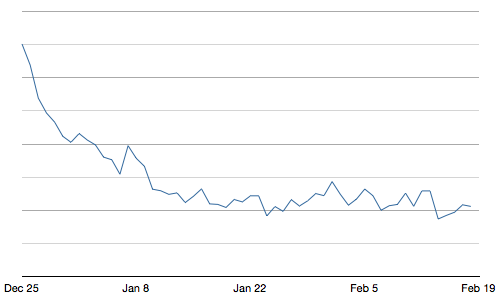Verizon iPhone selling mostly to existing iPhone owners?
https://marco.org/2011/02/20/verizon-iphone-selling-mostly-to-existing-iphone
Instapaper’s App Store rank is very stable. It’s almost always between #2 and #5 in the paid News categories on iPhone and iPad, and usually around #90-110 in the top-paid iPad category.
Since my ranks rarely change significantly, the resulting sales volumes seem to track the entire App Store’s volume. In other words, since my rank is held mostly constant, but my sales vary, it’s reasonable to extrapolate that trends in my sales indicate approximate trends in the entire App Store market.
The results are fairly obvious: I see huge spikes whenever there’s a new iPhone, iPod Touch, or iPad released, whenever they become available in a major new country, or whenever there’s a major reason for people to buy a lot of them (like the holidays).
Here’s every major spike from November 1, 2010 to February 18, 2011, relative to the average during that period:
- November 11, the day after a major new version that got a lot of press: 1.96 times the average.
- December 12, with a major New York Times feature: 2.86 times the average.
- December 25, Christmas day: 2.48 times the average, with a gradual decline to the average by around January 6. (My rank was nearly constant during this time.)
Here’s the sales graph from Christmas day forward:

The entire span from mid-January through February 18 has only been about 0.8 times the average since November 1, indicating a moderate month so far with no significant spikes.
But the Verizon iPhone launched on February 10.
And my sales haven’t noticed. Ranks have held nearly constant, but so have volumes.
Assuming the correlation is approximately sound, this can be explained by three possibilities:
- Very few Verizon iPhones have been sold. I don’t think this is likely.
- Verizon iPhone owners are buying very few apps relative to other iPhone owners. This also seems unlikely.
- Most Verizon iPhones have been sold to existing iPhone or iPod Touch1 owners, who therefore already own most or all of the apps they want. This seems like the most likely explanation by far.
At first, this worried me. I’ve been assuming that the Verizon iPhone launch was going to be a massive boom, and it looks like it’s been fairly average so far. But now I have a different theory: that the Verizon iPhone demand is from more casual buyers, by definition, and will therefore be spread gradually over the next 18 months.
In order to get a Verizon iPhone between its launch and now, a buyer would need to have either stayed up until 3 AM EST and bought before 5 AM when they sold out, or have gone to a store within the last week and hoped they were in stock. (From what I understand, stock hasn’t been widely constrained.) But, more importantly, excluding the small portion of buyers within a few months of their 2-year contract’s end date, most buyers so far had to break a contract or pay a premium for a partially unsubsidized iPhone.
My hypothesis is that most people willing and able to do that for the iPhone were also willing and able to jump carriers to get an iPhone on AT&T sometime since its release nearly four years ago. And that the huge amount of more casual Verizon buyers — the ones whose arrival to the App Store I’ve been eagerly awaiting — are far more likely to wait for their contracts to expire.
These buyers have different priorities than us geeks. They’re more patient for upgrades and more tolerant of crappy phones (after all, crappy phones are all they know). For potentially the same reasons that they didn’t jump carriers to get the iPhone, they also aren’t willing to pay the unsubsidized cost to get one early. (And they’re also more likely to choose to wait until this summer if their geeky friends tell them that the iPhone 5 is around the corner.)
So I think that, while the Verizon iPhone’s sales are going to be strong overall, it’s going to be at a far more gradual rate than people like me had initially assumed.
-
I excluded the iPad from this based on this reasoning: if someone owned only an iPad before, and then bought an iPhone, they’d probably buy a lot of apps for the iPhone anyway instead of just sticking with their existing iPad purchases because the most popular apps on both platforms have relatively little overlap. ↩︎